reviewed by Christina Lopez
When we talk of a terrarium, your mind should think along the indoor garden lines within a container. In most cases, the containers are clear glass or plastic. Nowadays, terrariums are used as decorative items. This works well for people who have busy schedules and therefore have little time to take care of a garden and still want greenery in their homes. If you have a small living space and do not have a garden, this is an excellent project. Terrariums occupy very little space.
There are many types of terrariums. We can categorize them according to their appearance and functionality or the kind of plants to grow in them. Based on the functionality and appearance, we have open and closed terrariums. To be clear, all terrariums fall under one of those two categories. The different terrariums have different requirements and maintenance practices. A good example is the water requirement. Understanding them will help your terrarium thrive. Below are the different types of terrariums:
Contents
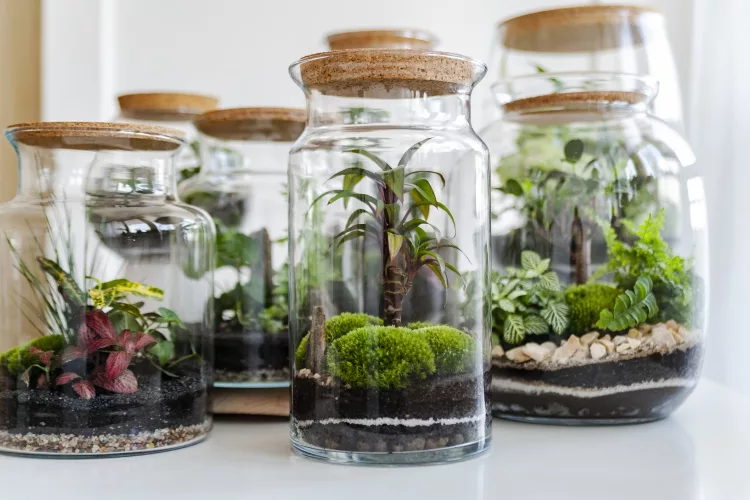
This kind of terrarium consists of plants in a transparent container with a removable lid. It serves as a miniature ecosystem because the plants have everything they need to survive within the container. There is a water cycle and a carbon-oxygen cycle. The plants feed on the nutrients in the soil for their growth, and once they die, the nutrients go back to the soil. The cycles make the terrarium self-sustaining.
For the water cycle, both the soil and plants release moisture to the air in the container. The moisture condenses on the cooler parts of the container wall. The tiny droplets collect together and fall back into the soil, and the process continues. That means that you will barely need to water your plants.
During the day, the plants consume carbon dioxide for photosynthesis and produce oxygen. At night, they use oxygen for respiration and produce carbon dioxide. That is where the carbon-oxygen cycle comes from.
Most people use glass containers because they allow light to pass through easily. Light is important for photosynthesis to take place. That process is what makes it possible for plants to make their food. Direct sunlight should be avoided because the glass magnifies the light and traps excess heat, which could burn or kill the plants. It is best to keep the containers in spots that receive indirect sunlight. Closed terrariums have a high light intensity requirement. You could use LED or fluorescent bulbs to supplement the natural light. Where the light is only coming in from a single direction, you can keep adjusting the terrarium to ensure balanced growth.
The best plants to grow in closed terrariums are the ones that grow slowly and that have less foliage. That means that it takes longer for you to prune. Remember, the goal is to have as little maintenance as possible. The closed terrarium plants enjoy high humidity and moisture. They are usually the tropical plants such as ferns, carnivorous plants, mosses, and ivies. For the ferns, you can choose from Button, Birds nest, and Maidenhair. Examples of carnivorous plants are Sundew, Venus flytrap, and Pitcher.
Excess moisture is the number one killer for closed terrariums. The soil should be moist. Soggy soil is an indication of excess watering. The excess water makes it hard for the roots to breathe. If left in that state, the roots will eventually rot. Tiny water droplets on the glass walls show that the terrarium is healthy. When there is excess moisture, keep the lid open to allow air circulation.
To test whether you need to water, place your finger on the leaves or in the soil. Suppose they are both dry, water the terrarium. The best practice is to use a misting bottle for the small terrariums and a spray bottle for the bigger terrariums. Plants drooping in wet soil are signs of root rot, while wilting or yellowing plants in dry soil show they need water.
For proper drainage, put small rocks on the last layer. Put charcoal on the next layer to purify the water and potting the soil on top of it. Good drainage is good for the roots of your plants and soil.
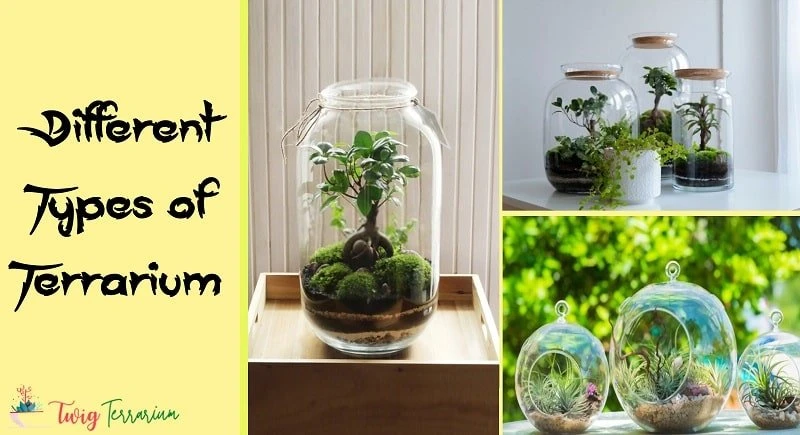
The open terrariums do not have lids. That means that, unlike the closed terrariums, they do not have a water cycle. The frequent flow of air makes sure of that. For people who have never had a garden before, open terrariums would be an excellent choice to begin with. The constant airflow promotes your plants’ growth, avoids condensation problems and the risk of root rot and mold. That means that you have more control of the moisture levels in your terrarium.
You cannot grow tropical plants in the open terrariums because the conditions are not conducive. The best plants to grow would be arid plants or succulents such as cactus, hens and chicks, dwarf aloe, Crassula, Hawthornia, and Echeveria. The open terrarium plants enjoy good air circulation and a dry environment.
For the open terrarium, you will need to water your plants regularly. However, space out the watering periods. You do not want the soil to be soggy because that may lead to root rot. The succulents generally do not enjoy excess water.
The terrarium should be placed in direct sunlight. Avoid the shaded areas when choosing the right spot. In most cases, arid plants do not require pruning because their growth is not rapid. However, in comparison to the closed terrarium, the closed terrarium plants need more pruning.
If you are building your terrarium, put small rocks at the bottom, then a layer of charcoal. On top of that, add the potting soil. You could add a little sand to your soil. The final layer should have small pebbles. That layering will promote drainage after every watering session.
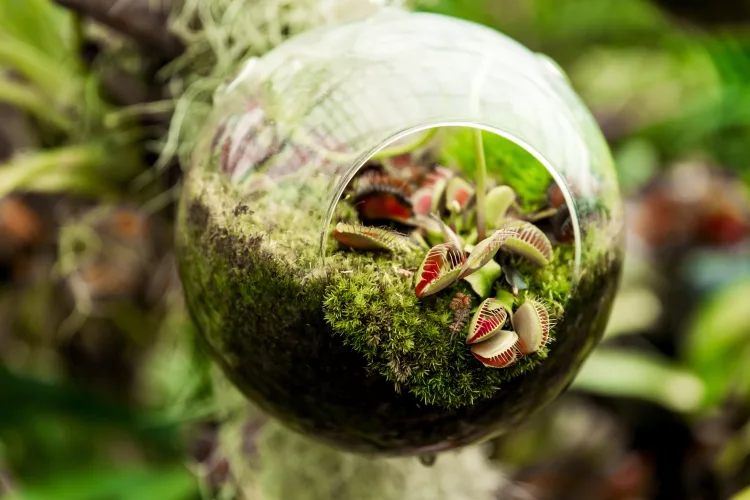
The air plant terrariums give you many choices when it comes to the base. You could use decorative sand, marbles, seashells, small rocks, moss, and bark for your base. The moss could absorb excess moisture. Preserved moss is better than living moss because it is less moist. You can choose from reindeer, sphagnum, and sheet moss. Ensure that your base is dehydrated. It is vital to note that you do not have to use soil. That is because air plants have specialized leaves that supply nutrients and water to the entire plant. Most of them have pretty flowers, making them a good décor piece.
For air plant terrariums, use open glass containers to ensure sufficient air circulation. Ensure that the plants can get enough light. For that, glass is the way to go. You can hang the containers or place them on a surface. If you decide to hang them, ensure your base does not shift. Sand would be good for one that sits on a surface.
When it comes to watering the plants, avoid doing so when they are in the containers. That will prevent your base from being moist. First, take the plants out, water them, let them dry thoroughly, and put them back in the terrarium. The plan is to avoid condensation.
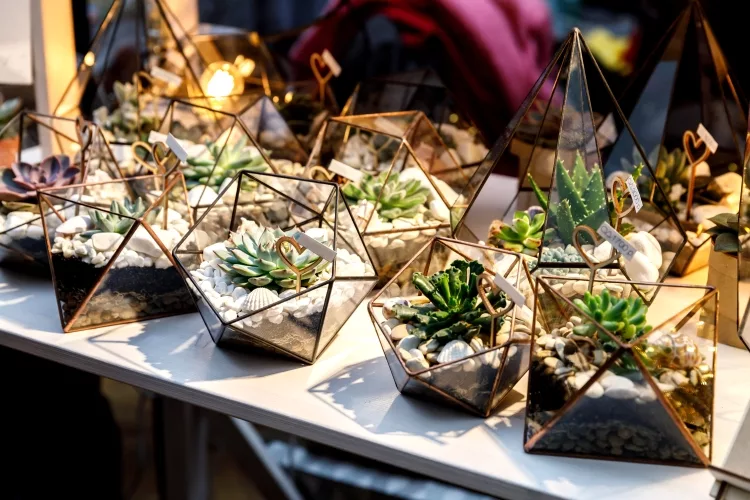
Use open containers for the succulents. Ensure that there is good drainage to avoid rotting. You could do that by adding charcoal, gravel, or small rocks. Succulents are plants that store water in their leaves. They thrive with little attention. They do not like moisture. Therefore ensure that your soil is mostly dry.
Succulents have broad and deep roots to maximize water absorption. Avoid overcrowding them and ensure the soil layer is deep to avoid stunting their growth.
Ensure the walls of your container do not encourage condensation. The best containers are those that have low walls. The more open terrariums prevent overheating, which dries out the roots of the plants and eventually kills them.
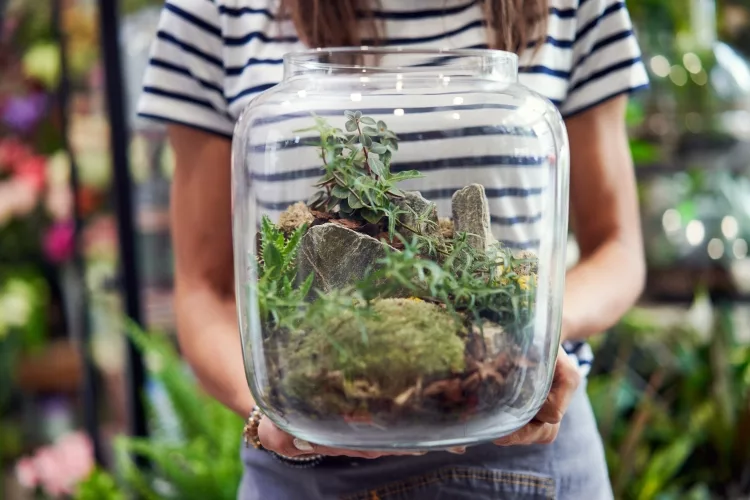
This terrarium allows you to grow tropical plants. Those are plants that thrive in humid conditions. Use the closed containers to create a miniature ecosystem for the plants. You can use living moss as a base to keep the soil moist.
For this, you can opt to do away with the drainage layers, especially if you want to grow air plants. It is suitable for plants that need little humidity and watering. You can quickly get away with using any lighting. The plants should grow slowly. You can use a dish that has drainage holes but ensure that it has a saucer underneath. In case of overwatering, the drainage holes will come in handy.
If you do decide to DIY your terrarium, ensure that you grow plants with the exact requirements. You want to avoid growing a cactus and moss in the same container. That is because for one to survive, the other will have to die. Ensure you have the proper drainage layers for your terrarium.
Remember that all this is trial and error. So do not beat yourself up if you get it wrong a couple of times. The important thing is to keep learning from your mistakes and have lots of fun.
 |
 |
 |
 |

About Christina Lopez
Christina Lopez grew up in the scenic city of Mountain View, California. For eighteen ascetic years, she refrained from eating meat until she discovered the exquisite delicacy of chicken thighs. Christina is a city finalist competitive pingpong player, an ocean diver, and an ex-pat in England and Japan. Currently, she is a computer science doctoral student. Christina writes late at night; most of her daytime is spent enchanting her magical herb garden.
 |
 |
 |
 |
Get new FREE Gifts. Or latest free growing e-books from our latest works.
Disable Ad block to reveal all the links. Once done, hit a button below
 |
 |
 |
 |